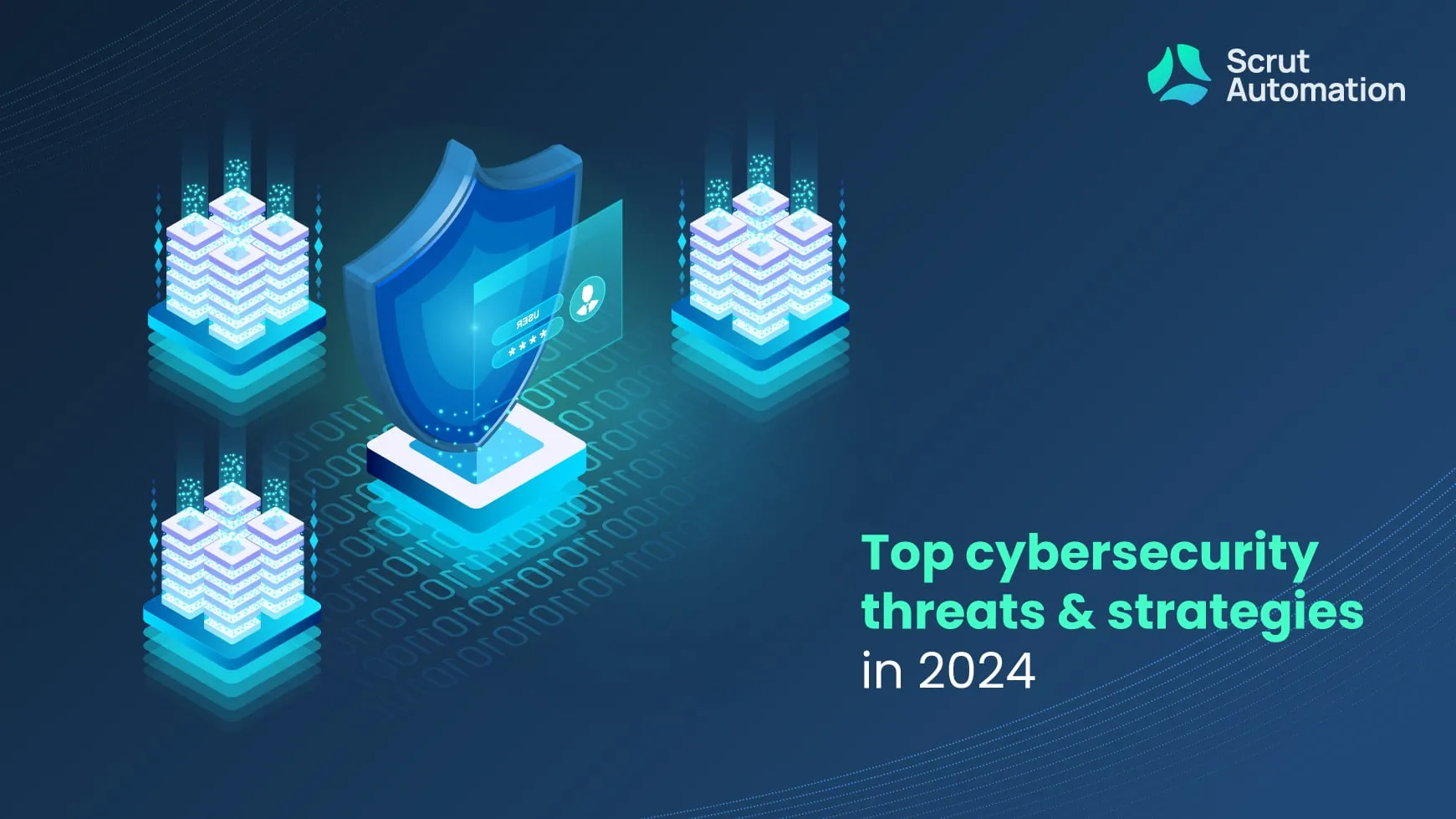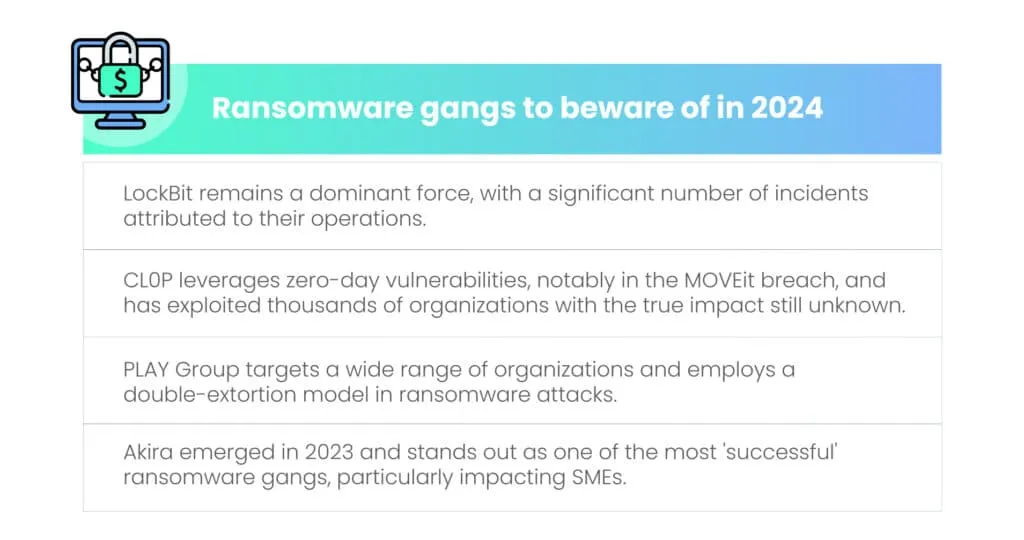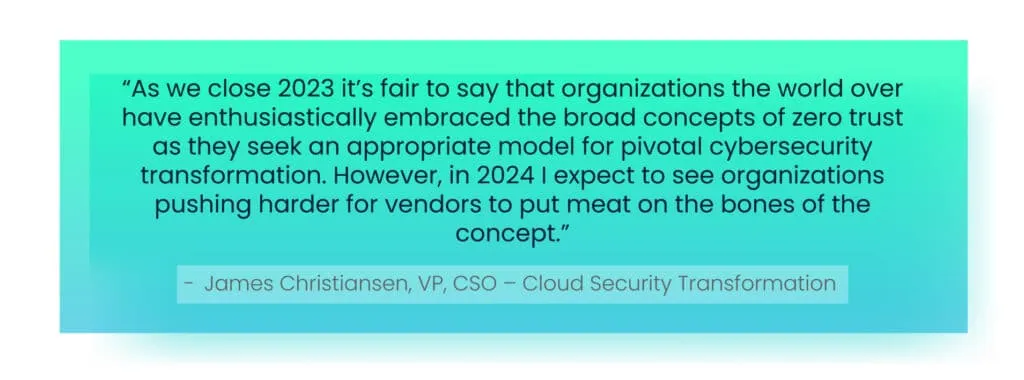Top cybersecurity threats and strategies in 2024

New year, new risks? Unfortunately, that’s the way things roll in the world of cyber crime where threat actors evolve strategically to gain access to sensitive information. From avoidable phishing emails to complicated zero-day attacks, there’s a lot to be wary of.
But fear not – the cybersecurity industry is armed with effective strategies to combat the most sinister of cyber criminals. Whether it’s leveraging artificial intelligence or enhancing the Internet of Things (IoT) security, there’s a variety of tools to bolster your information security toolkit.
Since it’s important to stay a step (or more) ahead in the landscape of potential threats, we bring to you cybersecurity trends and threats to watch out for in 2024, including cyber-attacks to beware of and security practices to adopt.
5 threats to steer clear of
As technology continues to advance and open new doors, threat actors constantly innovate ways to gain entry, exploiting the expanding attack surface. 2023 was fraught with data breaches that targeted private organizations (like T-Mobile USA’s data breach) and even governments (eg: Bangladesh’s government website leaks). It’s highly likely that 2024 will follow a similar, if not worse, trajectory, so it’s best to be prepared. Here’s a look at five threats to watch out for this year.

1. Zero-Day Attacks
What are zero-day attacks?
A zero-day attack is a cyberattack that exploits undisclosed vulnerabilities in software or hardware for which no patches or fixes are available since the developers have had zero days to address and mitigate the newly discovered flaw.
In a zero-day attack, threat actors take advantage of the time gap between the discovery of the vulnerability and the release of a fix, aiming to compromise systems, steal data, or carry out malicious activities.
These attacks are particularly challenging to defend against because there is no pre-existing defense or security patch available to protect against the specific exploit. Organizations often employ proactive security measures, such as regular updates, patch management, and threat intelligence, to minimize the risk associated with zero-day vulnerabilities.
What happened in 2023
Last year witnessed several zero-day attacks, the most notorious one being the MOVEit data breach. Microsoft Threat Intelligence Center attributed the exploitation of the MOVEit Transfer flaw to the threat actor Lace Tempest, associated with the Clop ransomware gang.
Numerous victims, including government agencies, British Airways, Extreme Networks, and Siemens Energy, emerged through data breach disclosures and Clop’s data leak site.
The attacks, focused on data theft rather than deploying ransomware, affected a staggering number, estimated at 2,095 organizations and over 62 million individuals by Emsisoft in September.
What’s likely to happen in 2024
The likelihood of an increase in zero-day attacks remains a concern due to several factors. Advanced Persistent Threats (APTs) and sophisticated cybercriminal groups continually invest in discovering and exploiting zero-day vulnerabilities for targeted attacks.

The expanding underground market for buying and selling such exploits, the complexity of modern software, and the potential for supply chain attacks contribute to the heightened risk. Additionally, state-sponsored cyber activities, geopolitical tensions, and the ongoing challenge of staying ahead in cybersecurity research and defense efforts further underscore the potential for a rise in zero-day attacks.
Organizations should prioritize robust cybersecurity measures and proactive defense strategies to mitigate these evolving threats.
The very first month of 2024 saw two major companies – Apple and Google – patching their first zero-day flaws of the year. Enterprise firms are now preparing for another year of addressing security issues, with crucial fixes released by prominent companies such as Cisco and SAP.

2. Supply chain attacks
What is a supply chain attack?
A supply chain attack is a type of cyberattack that targets the vulnerabilities in a system’s supply chain – the network of organizations, people, activities, information, and resources involved in the production and delivery of a product or service.
In the context of cybersecurity, a supply chain attack typically involves exploiting weaknesses in the supply chain to compromise the security of the end product.
What happened in 2023
Research from Gartner reveals that nearly 61% of U.S. businesses experienced direct impacts from software supply chain attacks from April 2022 to April 2023.
The headline-stealing MOVEit breach was the biggest example of a supply chain attack that took place last year with its cost exceeding $9.9 billion, impacting over 1000 businesses and more than 60 million individuals.
What’s likely to happen in 2024
The likelihood of an increase in supply chain attacks is a concern that cannot be ignored this year. Several factors contribute to this potential trend.
The increasing interconnectedness and complexity of global supply chains provide more opportunities for attackers to exploit vulnerabilities. Additionally, the rising sophistication of cybercriminals, the use of advanced techniques, and the expanding underground market for cyber exploits contribute to the heightened risk of supply chain attacks.
Geopolitical tensions and nation-state activities are other challenges in the way of securing supply chains. However, efforts to enhance cybersecurity awareness, implement robust defense mechanisms, and promote collaboration between industry and security communities are crucial in mitigating the risk and impact of supply chain attacks. Organizations should remain vigilant and prioritize proactive measures to strengthen the security of their supply chains.

3. Ransomware
What is ransomware?
Ransomware is a type of malicious software designed to deny access to a computer system or files until a sum of money, or ransom, is paid to the attacker.
It typically encrypts the victim’s files or entire system, rendering them inaccessible. The victim is then presented with a ransom demand and instructions on how to make the payment, often in cryptocurrency, like Bitcoins, Ethereum, Tether, or others.
Ransomware attacks can target individuals, businesses, or even government organizations.
The motives behind such attacks are usually financial, and the attackers seek to exploit the urgency and critical nature of the victim’s need to regain access to their data or systems.
What happened in 2023?
Over 72% of cybersecurity incidents in 2023 were attributed to ransomware. According to IBM, the share of breaches caused by ransomware increased by 41% in the past year, taking an average of 49 days longer to identify and contain.
The average ransom amount in 2023 surged to $1.54 million, nearly doubling the 2022 figure of $812,380. Alarmingly, more than 72% of businesses globally fell victim to ransomware attacks in 2023.
What’s likely to happen in 2024
Hong Kong’s Computer Emergency Response Team Coordination Centre suggests a potential shift by ransomware operators towards the APAC region.
APAC, housing some of the world’s fastest-growing economies, also presents opportunities due to the comparatively lower preparedness of many businesses, making it a greenfield investment for ransomware operators.
Additionally, APAC poses less risk to these operators compared to their traditional targets like the US, where increased scrutiny from government and law enforcement is observed.
This combination of reduced risk and heightened potential rewards may lead ransomware operators to continue focusing on APAC into 2024.

4. Cloud attacks
What are cloud attacks?
Cloud attacks have been on the rise as companies increasingly adopt cloud computing. These attacks refer to cybersecurity threats and exploits specifically aimed at cloud computing environments and services.
In cloud computing, data and applications are stored and accessed over the internet rather than on physical hardware. Cloud attacks can manifest in different forms, focusing on vulnerabilities within cloud infrastructure, applications, or the interactions between users and cloud services.
What happened in 2023?
According to Google Cloud’s Cybersecurity Forecast 2024, 2023 saw a notable increase in the use of zero-day vulnerabilities, with expectations of continued increase in 2024.
What’s likely to happen in 2024?
Based on Google’s report, in 2024, it is anticipated that cybercriminals and nation-state cyber operators will increasingly utilize serverless technologies in the cloud.
This shift is driven by the scalability, flexibility, and automation capabilities that serverless platforms offer, aligning with the preferences of developers adopting serverless architectures.
Edge devices and virtualization software will continue to be attractive to threat actors due to their challenging monitoring, while zero-day exploits are likely to increase the number of victims, enhancing the likelihood of high ransomware or extortion payments.
With the U.S. presidential election approaching, cyber activities, including espionage, influence operations, and spear phishing, are anticipated to intensify, involving nations like China, Russia, and Iran, potentially leveraging gen AI tools for increased scale and operational tempo.

5. Ransomware as a Service (RaaS)
Ransomware as a Service (RaaS) is a cybercriminal business model that allows individuals with limited technical expertise to launch ransomware attacks.
In this model, experienced ransomware developers create and maintain the malicious software, while less skilled individuals, often referred to as “affiliates” or “customers,” can use or lease the ransomware to carry out attacks.
The affiliates typically receive a portion of the ransom payments collected from victims, and the RaaS provider retains a percentage as well.
What happened in 2023?
Ransomware as a Service really shook the world of cybersecurity in 2023, resulting in the White House classifying ransomware as a national security threat in its National Cybersecurity Strategy.
The past year witnessed RaaS providers, specialized in specific aspects of the attack process, offering kits that encompassed everything a potential attacker needed.
What’s likely to happen in 2024?
According to insights from Cybersecurity Ventures, companies could potentially incur an annual cost of nearly $265 billion from ransomware by the end of 2031.
Meanwhile, threat actors are likely to find considerable value in Ransomware-as-a-Service, as subscriptions to RaaS kits can be as affordable as $40 per month.
RaaS providers will continue to offer comprehensive tools like payment portals, specialized support services, and various ransomware variants like LockBit, Revil, and Dharma, allowing for the creation of customized ransomware attacks.
5 cybersecurity strategies to embrace
Now that we have the scary parts covered, let’s move on to some good news! By embracing the following 2024 cybersecurity trends, you can help keep your organization safe from threat actors and their evolving evil ploys.
1. AI and Machine Learning
Leveraging Artificial Intelligence (AI) and Machine Learning (ML) empowers security systems to analyze vast datasets, identify patterns, and detect anomalies in real time.
By automating threat detection and response, organizations can enhance their ability to identify and neutralize potential security risks swiftly.
In 2024, AI and ML will play an increasingly crucial role in cybersecurity. AI’s advanced data analysis enhances early threat detection, with ML algorithms evolving to recognize and respond to new threats, improving defensive measures over time.
Expect real-time threat analysis from AI algorithms for faster and more accurate responses. ML is likely to autonomously adapt and update cybersecurity protocols, reducing the need for manual interventions.
2. Blockchain
Blockchain technology is gaining prominence as a cybersecurity asset. Its decentralized and immutable nature makes it a robust solution for securing sensitive data and transactions.
By implementing blockchain, organizations can establish transparent and tamper-resistant systems, reducing the risk of unauthorized access and ensuring the integrity of critical information.
3. Cybersecurity insurance
As cyber threats become more sophisticated, the importance of cybersecurity insurance is on the rise.
Having a solid cybersecurity insurance policy can provide financial protection in the event of a cyber incident.
It covers costs related to data breaches, ransom payments, and recovery efforts, offering organizations a safety net against the potential financial fallout of a cyberattack.
4. IoT Security
Internet of Things (IoT) security is gaining ground as one of the most viable cybersecurity industry trends in 2024.
It is a critical aspect of cybersecurity that focuses on safeguarding the interconnected devices and systems within the IoT ecosystem.
As the number of IoT devices continues to surge across various sectors, ranging from smart homes and healthcare to industrial settings, ensuring robust security measures is extremely important.
By mitigating vulnerabilities and exploits, IoT security contributes to the overall resilience of networks and systems, reducing the risk of cyberattacks and potential disruptions.

5. Zero Trust
In 2024, the importance of adopting a Zero Trust security model has never been more critical. With the evolving cyber threat landscape and increasingly sophisticated attacks, the traditional perimeter-based security approach is no longer sufficient.
Zero Trust challenges the notion that entities, whether inside or outside the organization, should be automatically trusted. By requiring continuous verification of the identity and security posture of users, devices, and applications, Zero Trust establishes a more resilient defense against both internal and external threats.
This approach aligns with the dynamic nature of modern work environments, where remote access, cloud services, and mobile devices are prevalent.
Embracing Zero Trust is essential to fortify cybersecurity postures and ensure that organizations stay ahead of the curve in mitigating potential security risks.

Wrapping up
As we wrap up our insights into the cybersecurity landscape for 2024, it’s clear that organizations will face a dynamic set of challenges in the realm of digital security. From the ongoing threat of zero-day attacks exploiting vulnerabilities to the growing risks associated with supply chain vulnerabilities, the importance of robust cybersecurity measures is clear as day.
The emergence of ransomware as a service (RaaS) adds a layer of complexity, highlighting the need for proactive defense strategies. Fortunately, there is encouraging news in the form of emerging cybersecurity trends.
Embracing AI and machine learning for real-time threat analysis, integrating blockchain technology for decentralized security, investing in cybersecurity insurance for financial protection, prioritizing IoT security in the face of increasing attacks, and adopting the Zero Trust security model are key strategies for building resilient defense mechanisms.
As we navigate the intricacies of 2024, organizations should focus on staying ahead of cyber threats, fostering collaboration within the industry and security communities, and continually enhancing cybersecurity awareness. A holistic and proactive approach is essential to safeguard sensitive data, maintain trust, and uphold the integrity of our digital ecosystems.

FAQs
1. What is a zero-day attack?
A zero-day attack is a cyberattack that exploits undisclosed vulnerabilities in software or hardware for which no patches or fixes are available. Threat actors take advantage of the time gap between the discovery of the vulnerability and the release of a fix, aiming to compromise systems, steal data, or carry out malicious activities.
2. What happened in the MOVEit data breach in 2023?
The MOVEit data breach in 2023 was a notable zero-day attack attributed to the threat actor Lace Tempest, associated with the Clop ransomware gang. The attackers focused on data theft rather than deploying ransomware, impacting a staggering number of victims, estimated at 2,095 organizations and over 62 million individuals.
3. What is a supply chain attack?
A supply chain attack is a type of cyberattack that targets vulnerabilities in a system’s supply chain – the network of organizations, people, activities, information, and resources involved in the production and delivery of a product or service. In cybersecurity, this attack typically involves exploiting weaknesses in the supply chain to compromise the security of the end product.
4. What is Ransomware as a Service (RaaS)?
Ransomware as a Service (RaaS) is a cybercriminal business model that allows individuals with limited technical expertise to launch ransomware attacks. Experienced ransomware developers create and maintain the malicious software, while less skilled individuals, referred to as “affiliates” or “customers,” can use or lease the ransomware to carry out attacks.


















